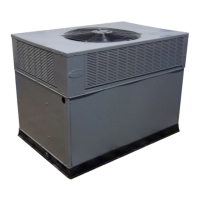Unsafe operation of the unit may result if manifold pressure
is outside this range. Serious injury or unit damage may
result.
3. Replace cover screw cap on gas valve.
4. Turn off gas supply to unit. Remove manometer from pressure
tap and replace pipe plug on gas valve. Turn on gas to unit and
check for leaks.
MEASURE MANIFOLD PRESSURE (PROPANE UNITS)
— The main burner orifices on a propane unit are sized for the
unit rated input when the manifold pressure reading matches the
level specified in Table 6.
If converting to propane gas, remove the burner assembly and
inspect the heat exchanger tubes. If there are V-shaped NOx
baffles installed in the firing tubes, THEY MUST BE
REMOVED.
Discard the baffles after removal.
Refer to Maintenance section for information on burner
removal.
Proceed as follows to adjust gas input on a propane gas unit:
1. Turn off gas to unit.
2. Remove pipe plug on manifold (see Fig. 18) then connect
manometer at this point.
3. Turn on gas to unit.
4. Remove cover screw over regulator adjustment screw on gas
valve.
5. Adjust regulator adjustment screw to the correct manifold
pressure, as specified in Table 6. Turn adjusting screw
clockwise to increase manifold pressure, or turn adjusting
screw counterclockwise to decrease manifold pressure.
6. Replace cover screw.
7. Turn off gas to unit. Remove manometer from pressure tap.
Replace pipe plug on gas valve, then turn on gas to unit. check
for leaks.
CHECK BURNER FLAME—With burner access panel removed,
observe the unit heating operation. Watch the burner flames to see
if they are light blue and soft in appearance, and that the flames are
approximately the same for each burner. Propane will have blue
flame with yellow tips. (See Fig. 19). Refer to Maintenance section
for information on burner removal.
AIRFLOW AND TEMPERATURE RISE—The heating section
for each size unit is designed and approved for heating operation
within the temperature rise range stamped on the unit rating plate.
Table 7 shows the approved temperature rise range for each
heating input, and the air delivery cfm at various temperature rises.
The heating operation airflow must produce a temperature rise that
falls within the approved range.
Refer to Indoor Airflow and Airflow Adjustments section on the
following pages to adjust heating airflow when required.
Fig. 18—Burner Assembly
C99019
MANIFOLD PIPE PLUG
Fig. 19—Monoport Burners
C99021
MANIFOLD
BURNER
BURNER FLAME
15

